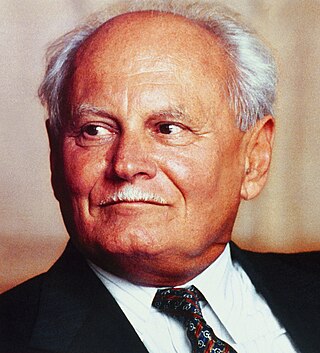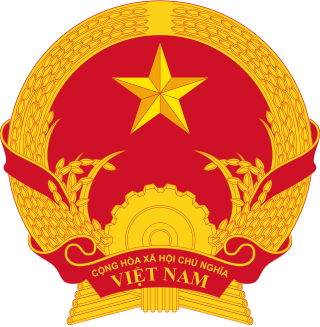
A communist state, also known as a Marxist–Leninist state, is a one-party state that is administered and governed by a communist party guided by Marxism–Leninism. Marxism–Leninism was the state ideology of the Soviet Union, the Comintern after Bolshevisation and the communist states within the Comecon, the Eastern Bloc, and the Warsaw Pact. Marxism–Leninism currently still remains the ideology of a few parties around the world. After its peak when many communist states were established, the Revolutions of 1989 brought down most of the communist states, however, it is still the official ideology of the ruling parties of China, Cuba, Laos, Vietnam, and to a lesser extent, North Korea. During most of the 20th century, before the Revolutions of 1989, around one-third of the world's population lived under communist states.

The Constitution of East Germany refers to the constitution of the German Democratic Republic, commonly known as East Germany. Its original constitution was promulgated on 7 October 1949. It was heavily based on the "Weimarer Reichsverfassung", and nominally established the GDR as a liberal democratic republic. In 1968 the East German government adopted a new, fully Communist constitution that was based on Marxism-Leninism, political unitarism, and collective leadership. There were further amendments to the 1968 constitution in 1974. With the political events of 1989, there were attempts to draft a new constitution for East Germany, but these efforts never materialized due to the dissolution of East Germany and the accession of its Länder into the neighboring Federal Republic.

Árpád Göncz was a Hungarian writer, translator, agronomist, and liberal politician who served as President of Hungary from 2 May 1990 to 4 August 2000. Göncz played a role in the Hungarian Revolution of 1956, for which he was imprisoned for six years. After his release, he worked as a translator of English-language literary works.

Péter Medgyessy is a retired Hungarian politician who served as Prime Minister of Hungary from 27 May 2002 to 29 September 2004. On 25 August 2004, he resigned over disputes with coalition partner Alliance of Free Democrats, but remained as acting prime minister for a 30-day period as required by the Constitution, and a few additional days until his successor Ferenc Gyurcsány was confirmed by the National Assembly.

The Constitution of the Czech Republic is the supreme law of the Czech Republic. The current constitution was adopted by the Czech National Council on 16 December 1992. It entered into force on 1 January 1993, replacing the 1960 Constitution of Czechoslovakia and the constitutional act No. 143/1968 Col., when Czechoslovakia gave way to the Slovak Republic and the Czech Republic in a peaceful dissolution.

The Constitutional Court of Hungary is a special court of Hungary, making judicial review of the acts of the Parliament of Hungary. The official seat of the Constitutional Court is Budapest. Until 2012 the seat was Esztergom.

The Hungarian Democratic Forum was a centre-right political party in Hungary. It had a Hungarian nationalist, national-conservative, Christian-democratic ideology. The party was represented continuously in the National Assembly from the restoration of democracy in 1990 until 2010. It was dissolved on 8 April 2011.

Péter Boross is a retired Hungarian politician and former member of the Hungarian Democratic Forum (MDF) who served as Prime Minister of Hungary from December 1993 to July 1994. He assumed the position upon the death of his predecessor, József Antall, and held the office until his right-wing coalition was defeated in election by the Hungarian Socialist Party (MSZP), which was led by his successor Gyula Horn. Prior to his premiership, Boross functioned as Minister of Civilian Intelligence Services (1990) and Minister of the Interior (1990–1993). He was also a Member of Parliament from 1994 to 1998 and from 2006 to 2009.

The Constitution of the Socialist Republic of Vietnam is the current constitution of Vietnam, adopted on November 28, 2013, by the Thirteenth National Assembly, and took effect on January 1, 2014. It is the fourth constitution adopted by the Vietnamese government since the political reunification of the country in 1976.

The Hungarian People's Republic was a one-party socialist state from 20 August 1949 to 23 October 1989. It was governed by the Hungarian Socialist Workers' Party, which was under the influence of the Soviet Union. Pursuant to the 1944 Moscow Conference, Winston Churchill and Joseph Stalin had agreed that after the war Hungary was to be included in the Soviet sphere of influence. The HPR remained in existence until 1989, when opposition forces brought the end of communism in Hungary.
The Fundamental Law of Hungary, the country's constitution, was adopted by parliament on 18 April 2011, promulgated by the president a week later and entered into force on 1 January 2012. It is Hungary's first constitution adopted within a democratic framework and following free elections.

The Constitution of Latvia is the fundamental law of the Republic of Latvia. Satversme is the oldest Eastern or Central European constitution still in force and the sixth oldest still-functioning republican basic law in the world. It was adopted, as it states itself in the text, by the people of Latvia, as represented in the Constitutional Assembly of Latvia, on 15 February 1922 and came into force on 7 November 1922. It was heavily influenced by Germany's Weimar Constitution and the Swiss Federal Constitution. The constitution establishes the main bodies of government ; it consists of 116 articles arranged in eight chapters.

Parliamentary elections were held in Hungary on 25 March 1990, with a second round of voting taking place in all but five single member constituencies on 8 April. They were the first completely free and competitive elections to be held in the country since 1945, and only the second completely free elections with universal suffrage in the country's history. The conservative, nationalist Hungarian Democratic Forum (MDF) beat the liberal and more internationalist Alliance of Free Democrats, which had spearheaded opposition to Communist rule in 1989, to become the largest party in parliament. The Hungarian Socialist Party, the former Communist party, suffered a crushing defeat, winning only 33 seats for fourth place.
Hungary has recognized registered partnerships since 1 July 2009, offering same-sex couples nearly all the rights and benefits of marriage. Unregistered cohabitation for same-sex couples was recognised and placed on equal footing with the unregistered cohabitation of different-sex couples in 1996. However, same-sex marriage is prohibited by the 2011 Constitution of Hungary, which took effect in January 2012.

The Preamble to the Constitution of India presents the principles of the Constitution and indicates the sources of its authority. It was adopted on 26 November 1949 by the Constituent Assembly and came into effect on 26 January 1950, celebrated as the Republic Day of India. It was amended during the Indian emergency by Indira Gandhi where the words "socialist" and "secular" were added.

Communist rule in the People's Republic of Hungary came to an end in 1989 by a peaceful transition to a democratic system. After the Hungarian Revolution of 1956 was suppressed by Soviet forces, Hungary remained a communist country. As the Soviet Union weakened at the end of the 1980s, the Eastern bloc disintegrated.
Constitutional references to God exist in the constitutions of a number of nations, most often in the preamble. A reference to God in a legal text is called invocatio dei if the text itself is proclaimed in the name of the deity. A reference to God in another context is called nominatio dei. Such invocationes and nominationes dei are found notably in several European constitutional traditions and in the constitutions of Islamic countries.

István Ákos Balsai was a Hungarian politician and jurist, who served as Minister of Justice between 1990 and 1994. He was a Member of Parliament from 1990 to 2011, when he was elected a member of the Constitutional Court of Hungary.

The first indirect presidential election was held in Hungary on 3 August 1990, following the transition to multi-party democracy. Árpád Göncz (SZDSZ), Speaker of the National Assembly and acting head of state, was elected President with an absolute majority.
















